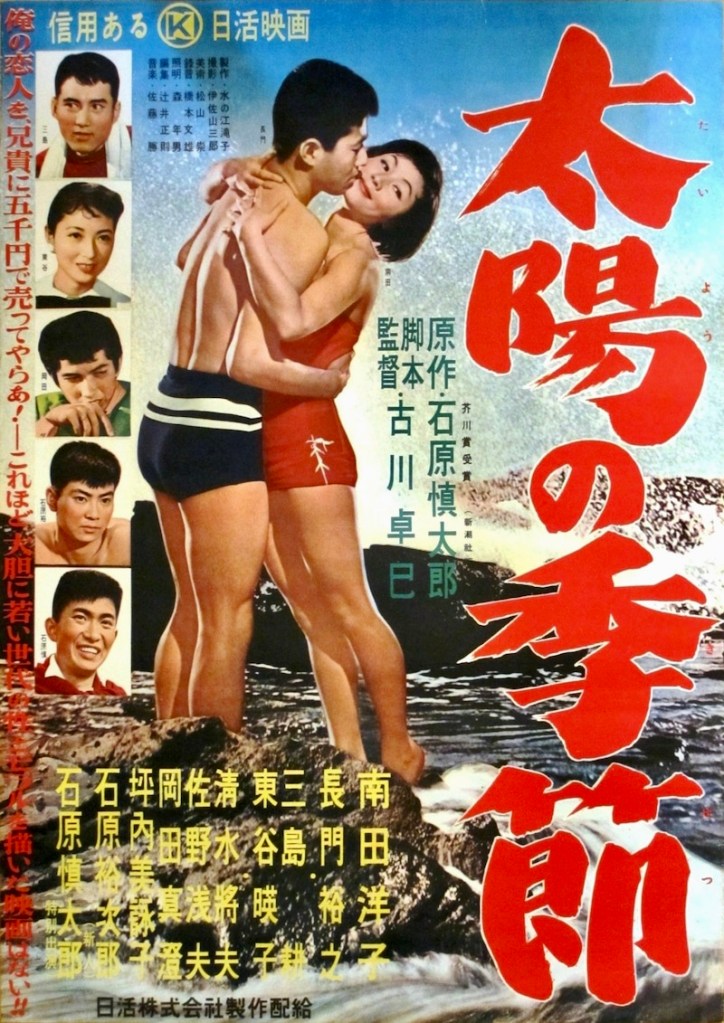When Ishihara Shintaro died on February 1, 2022 at age 89, most obituaries focused on his career as a politician in Japan. He first served as a member of the House of Councillors (1968 to 1972) and then as a member of the House of Representatives (1972-1995) before becoming the Governor of Tokyo from 1999 to 2012. A controversial figure in his own country, Shintaro was famous for his ultra-nationalist stance on Japan and extreme right-wing views such as discriminating against Japanese-Koreans, the disabled, women, LGBT and other social minorities. He is now considered an early proponent of “hate speech” and often denied historical accounts of atrocities committed by the Japanese against the Chinese in the infamous Nanjing Massacre of 1937, which in Japan is the same as being a Holocaust denier. What is most surprising about Shintaro, however, is his earlier career as an author and highly successful screenwriter for movie studios like Nikkatsu, Daiei and Shochiku. His critically acclaimed first novella, Taiyo no Kisetsu (English title: Season of the Sun), was published in 1955 and he adapted it into a film for director Takumi Furukawa. It became a box office sensation and inspired several successors in a film movement that became known as the “Sun Tribe” (aka Taiyozoku) movies.
Continue readingTag Archives: Kon Ichikawa
Detective Kindaichi vs. Ghostman Sagawa
Novelists who specialize in murder mysteries and thrillers with detective heroes are not exclusively British and American but practitioners of a worldwide literary tradition, especially in Japan where Edogawa Ranpo, Soji Shimada and Seishi Yokomizo are considered masters of the form. Yokomizo, for example, was so popular and prolific that he was often called the “Japanese John Dickson Carr,” a writer of American detective fiction who created such famous sleuths as Dr. Gideon Fell and Sir Henry Merrivale in his novels. Yokomizo became popular in the post-WW2 years with a series of “locked room” mystery thrillers that began with The Honjin Murders in 1946 featuring the detective hero Kosuke Kindaichi. Yet it wasn’t until 1954 when the character of Kindaichi was first portrayed on the screen by actor Seizaburo Kawazu in the murder mystery Yurei Otoko (English title: Ghost Man). It was the first of several Kosuke Kindaichi film adaptations but, for its era, it was also extremely racy for its female nudity as well as its disturbing narrative which follows the crimes of a cunning serial killer who preys on models.
Continue readingSubterranean Homesick Blues

Not all homecomings are happy affairs and, if you want to experience one that makes a good argument against family reunions, consider Yatsuhaka-mura (Japanese title, Village of Eight Gravestones, 1977), which presents the ancestral homestead as a cursed place with a dark history. Tatsuya (played by former pop singer Ken’ichi Hagiwara), the film’s protagonist, was taken away from his mountain village by his mother when he was just a child but when he returns after many years, he feels like the ultimate outsider as he reconnects with family he never really knew. Not only is his village isolated and mired in the past but it sits upon a network of underground caves and tunnels, which hold the key to a family secret.
Continue readingThe Cult of Kaze
There are good cults and bad cults and the cult of Kaze is a bit of both worlds. Not really a recognized cult, it is instead an informal club of ten women who are united in sisterhood over a common cause which they hope will result in their liberation from a certain Mr. Kaze, a handsome, successful executive in the television industry. The bad part of their mutual solidarity is that the women want Kaze to die and they aim to kill him. Why? Because nine of the women have had affairs with and been discarded by this man and the tenth woman, Futaba Kaze, is his wife and has suffered from his serial unfaithfulness for years. As you would expect from this set-up, Kuroi jûnin no onna (The English title translates as Ten Dark Women or Ten Women in Black), directed by Kon Ichikawa in 1961, is a feminist revenge film but it is also so much more than that.
Continue readingThe Girl with the Fishing Spear

In 1984 ATG (Art Theater Guild), one of the most experimental and artistic of Japan’s film distribution companies, and Directors Company, released Ningyo Densetsu, directed by Toshiharu Ikeda. ATG had already established itself as a cutting-edge visionary with such releases as Toshio Matsumoto’s Funeral Parade of Roses (1969), Shuji Terayama’s Pastoral: Hide and Seek (1974) and Seijun Suzuki’s Zigeunerweisen (1980). Ningyo Densetsu was something altogether different – a commercially viable fusion of murder mystery, white collar crime and revenge thriller which looked more mainstream than most of ATG’s previous releases. Also known as Mermaid Legend, the movie is also much more extreme than some of the most infamous exploitation films of its era yet it is distinguished by its artistry in all areas of production. But make no mistake, this is not family-friendly fare or recommended for fans of The Little Mermaid.
Continue readingBalm for the Soul
In 1955 Kon Ichikawa was a well established filmmaker in Japan who was mostly known for satiric comedies like Mr. Pu (1953) and A Billionaire (1954) and the occasional literary adaptation like Young People (1952). His work was still unknown outside of his own country but that would change with his 27th film, The Burmese Harp (Japanese title: Biruma no tategoto, 1956). It would prove to be his first major critical and box office success in Japan but also one that would bring him international acclaim. “That was the first film I really felt I had to make,” Ichikawa later admitted to author and film scholar Donald Richie. Continue reading




